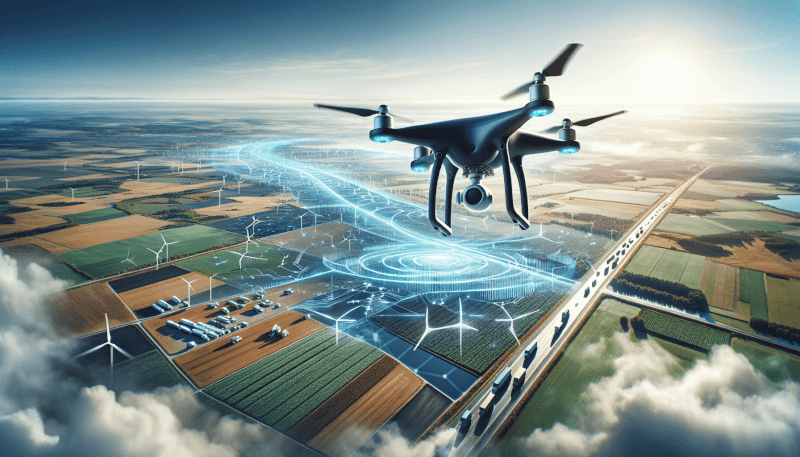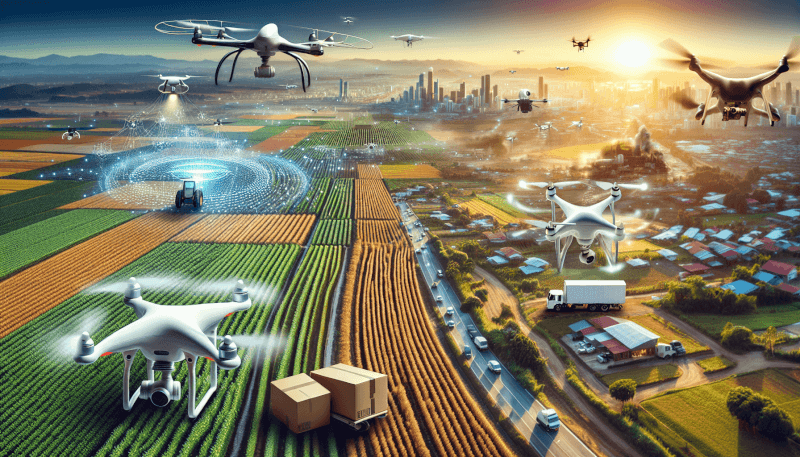Get ready for an exciting journey into the world of drones! In this article, we will be exploring the top 10 drone technology trends for 2021. From the latest advancements in aerial photography to the use of drones in various industries, this list will provide you with a glimpse into the future of drone technology. Whether you’re a drone enthusiast or simply curious about the possibilities that drones offer, this article will give you a friendly and informative overview of what to expect in the exciting year ahead. So buckle up and get ready to soar into the world of drones!
Increased use of artificial intelligence in drones
Artificial intelligence (AI) has revolutionized the drone industry, enabling drones to perform complex tasks autonomously. Advanced AI algorithms are now being developed to enhance autonomous flight capabilities. These algorithms enable drones to make real-time decisions, adapt to changing environments, and optimize flight paths based on various factors such as weather conditions and battery life. With AI-powered autonomous flight, drones can operate efficiently and safely, reducing the need for constant human intervention.
AI-powered object recognition and tracking have also significantly improved the capabilities of drones. Drones equipped with AI algorithms can accurately detect and identify objects in real-time, enabling them to perform tasks such as search and rescue missions, surveillance, and delivery. The ability to track objects with precision allows drones to follow moving targets, capturing high-quality footage or monitoring activities from a remote location. This increased level of intelligence and automation enhances the overall efficiency and effectiveness of drones in various industries.
Improved data processing capabilities have further propelled the use of AI in drones. Drones are now equipped with advanced processors, allowing for faster and more accurate data analysis. This ability is particularly useful in industries such as agriculture, where drones are used for crop monitoring and analysis. The AI algorithms can process large amounts of data collected by drones, providing valuable insights to farmers. By analyzing crop health, identifying pest and disease outbreaks, and optimizing irrigation and fertilizer application, AI-powered drones contribute to more efficient and sustainable agricultural practices.
Expanded applications in agriculture
Drones have found extensive applications in the agricultural sector, revolutionizing traditional farming practices. Crop monitoring and analysis are among the key areas where drones have made a significant impact. Equipped with high-resolution cameras and multispectral sensors, drones can capture detailed imagery of crops from different angles and wavelengths. This data can then be processed using AI algorithms to provide farmers with valuable information about crop health, growth patterns, and potential issues.
Precision agriculture techniques have also benefited from the use of drones. By utilizing GPS technology and advanced imaging capabilities, drones can precisely target specific areas within agricultural fields for interventions such as pesticide spraying or fertilizer application. This targeted approach minimizes the use of agrochemicals, reduces environmental impact, and maximizes crop yields.
Automated planting and spraying are other applications of drones in agriculture. Drones can be programmed to distribute seeds or spray fertilizers and pesticides over large areas with high precision. This automation saves time and labor, making the farming process more efficient and cost-effective. Drones equipped with AI algorithms can analyze field conditions and adjust their actions accordingly, ensuring optimal planting or spraying patterns.

Enhanced autonomous capabilities
Advancements in drone technology have led to improved obstacle avoidance systems, enhancing the autonomous capabilities of drones. Drones can now detect and avoid obstacles in real-time using sensors and AI algorithms. This feature is particularly crucial for applications such as inspection of infrastructure, where drones need to navigate complex environments to capture accurate data. By autonomously avoiding obstacles, drones can safely complete tasks while minimizing the risk of collisions or damage.
Intelligent flight planning and navigation are also driving the enhanced autonomous capabilities of drones. AI algorithms enable drones to analyze multiple factors, including weather conditions, airspace regulations, and optimal flight paths, to plan their missions efficiently. This results in optimized flight routes, reduced energy consumption, and improved safety. Drones can now navigate complex terrains, follow predetermined routes, and adjust their flight parameters in real-time based on changing conditions.
Automated takeoff and landing are key features that simplify the operation of drones. With AI algorithms, drones can autonomously take off and land, eliminating the need for skilled pilots and reducing human error. Automated takeoff and landing are particularly crucial in industrial applications, where drones need to operate in confined spaces or hazardous environments. This capability increases the versatility and accessibility of drones, enabling their use in various industries.
Miniature and foldable drones for portability
The portability of drones has become increasingly important as they find applications in different industries and environments. Miniature and foldable drones have emerged as a solution to this demand for easy transportation and storage. Compact designs have been developed, allowing drones to be conveniently carried in backpacks or small cases. These smaller drones are lightweight, making them ideal for outdoor enthusiasts and traveling professionals who require aerial photography or videography capabilities.
Foldable arms are another feature that enhances the portability of drones. These arms can be folded inwards, reducing the overall size of the drone and enabling it to fit into smaller spaces. Foldable drones are especially popular among adventurers and outdoor enthusiasts who need rugged, lightweight drones that can easily accompany them on their journeys.
Despite their compact size, small-sized drones now offer integrated features that were previously available only in larger models. Advanced stabilization systems, high-resolution cameras, and intelligent flight modes are now being incorporated into these compact drones. This integration of sophisticated features in smaller-sized drones provides users with a convenient and versatile tool for capturing high-quality aerial footage or conducting inspections in hard-to-reach areas.

Increased focus on safety features
As drone usage continues to grow, ensuring safety is of utmost importance. Manufacturers are placing a higher emphasis on incorporating safety features into drone designs. Collision avoidance systems are one such feature that has significantly improved the safety of drones. By utilizing sensors and AI algorithms, drones can detect obstacles in their flight path and automatically adjust their trajectory or altitude to avoid a collision. This feature is critical, especially in densely populated areas or complex environments where the risk of accidents is higher.
Geo-fencing technology is another safety measure implemented in drones to protect restricted or no-fly zones. By utilizing GPS and geolocation data, drones can be programmed to automatically avoid prohibited areas, such as airports or government facilities. This technology adds an extra layer of security and ensures that drones operate within legal boundaries. By integrating geo-fencing technology, drone manufacturers and operators are contributing to the overall safety and responsible use of drones.
Real-time flight monitoring systems have become standard in many drones, allowing operators to track and monitor the drone’s flight parameters. These systems provide real-time data on altitude, speed, battery life, and GPS coordinates, enhancing situational awareness and aiding in flight planning. Real-time flight monitoring ensures that drones operate within safe limits and enables operators to take corrective actions in case of any anomalies. This feature contributes to safer and more reliable drone operations.
Augmented Reality (AR) and Virtual Reality (VR) integration
The integration of AR and VR technologies with drones has opened up new possibilities for immersive experiences and training simulations. With first-person view (FPV) technology, users can experience the thrill of flying a drone from the drone’s perspective. FPV goggles or screens provide a live video feed from the drone’s camera, giving users a real-time view of the drone’s flight path and surroundings. This immersive experience allows users to explore their surroundings from an aerial perspective and capture stunning footage or images.
AR overlays enhance situational awareness by providing additional information overlaid onto the live video feed. For example, drones equipped with AR technology can display flight parameters, GPS coordinates, or even points of interest directly onto the live video stream. This additional information can be invaluable for industrial applications such as inspection or surveying, where precise data is required for analysis.
Training simulations in virtual environments offer a safe and cost-effective way to train drone operators. With VR technology, trainees can simulate flying a drone in various scenarios, such as adverse weather conditions or complex airspace. This immersive training allows operators to develop their skills, test different strategies, and familiarize themselves with potential challenges without the risk of damaging an actual drone. The integration of AR and VR technologies with drones is transforming training methodologies and improving the overall competency of drone operators.

Improved camera technology
Camera technology in drones has witnessed significant advancements, allowing for higher resolution imaging and smoother footage stabilization. Drones are now equipped with high-quality cameras capable of capturing images and videos in stunning detail. Higher resolution imaging enables users to zoom in on specific areas of interest or capture images with greater clarity. This is particularly useful in industries such as surveying, photography, or cinematography, where precision and image quality are essential.
Enhanced stabilization systems have also revolutionized aerial videography. Drones equipped with advanced gimbal systems can stabilize the camera, compensating for any unwanted movements or vibrations caused by wind or drone maneuvering. This stabilization ensures smooth and steady footage, eliminating the need for extra post-processing or editing. With improved stabilization systems, drones are increasingly being used in the film industry, capturing breathtaking aerial shots that were previously only possible with expensive helicopter setups.
Advanced zoom and tracking capabilities are additional features that enhance camera technology in drones. Drones can now zoom in on distant objects, capturing detailed footage from various perspectives. This zooming capability is particularly valuable in applications such as surveillance, wildlife monitoring, or inspection of tall structures. Additionally, drones equipped with tracking systems can lock onto moving targets and keep them in the frame, allowing for dynamic and compelling footage.
Growth of drone delivery services
Drone delivery services have gained significant momentum in recent years, and this trend is expected to continue in 2021 and beyond. With expanding delivery networks, drones are increasingly being used to transport goods in a faster and more efficient manner. From medical supplies and food delivery to e-commerce packages, drones offer a cost-effective alternative to traditional delivery methods.
Regulatory advancements, especially in terms of beyond visual line of sight (BVLOS) operations, have paved the way for the growth of drone delivery services. BVLOS operations allow drones to fly beyond the operator’s line of sight, expanding their range and capabilities. With appropriate regulations and air traffic control systems in place, drones can safely navigate long distances, delivering items to remote or inaccessible locations.
Integration with existing transportation systems is another driving force behind the growth of drone delivery services. Drones can be seamlessly integrated into existing logistics networks, providing last-mile delivery solutions. By leveraging existing infrastructure and technologies, such as delivery hubs or automated systems, drones can efficiently transport goods to their final destinations. This integration offers businesses and consumers faster delivery times, reduced costs, and increased accessibility to remote areas.

Sustainable power solutions
To address the limitations of battery life, sustainable power solutions are being explored in the drone industry. Longer battery life is a crucial aspect that further enhances the capabilities of drones. With longer flight times, drones can cover larger areas, perform more complex tasks, and reduce the need for frequent battery replacements. Manufacturers are continuously working on improving battery technology, increasing energy density, and optimizing power management systems to extend the flight time of drones.
Solar-powered drones have emerged as an environmentally friendly solution. By harnessing the power of the sun, these drones can recharge their batteries during flight, significantly extending their flight time. Solar-powered drones are particularly beneficial in applications where drones need to operate for extended periods without the need for manual intervention, such as environmental monitoring or wildlife conservation.
Hybrid propulsion systems combine multiple power sources, typically a combination of electric and combustion engines, to maximize efficiency and flight time. These systems allow drones to switch between power sources, optimizing energy consumption based on the task at hand. For example, a hybrid-powered drone can rely on its combustion engine for longer-distance flights and switch to electric power for more precise and energy-efficient operations. With hybrid propulsion systems, drones become more versatile and adaptable to different mission requirements.
Integration with Internet of Things (IoT)
The Internet of Things (IoT) has enabled drones to become interconnected devices, exchanging real-time data and collaborating on missions. Real-time data exchange is particularly valuable in scenarios where drones need to share information or collaborate with other drones or ground-based systems. For example, in search and rescue missions, drones can transmit live video feeds, GPS coordinates, or environmental data to the command center or other rescue teams, enabling coordinated efforts and faster responses.
Connected drones for collaborative missions are now being implemented in various industries. By working together, multiple drones can cover larger areas, perform complementary tasks, or execute complex operations more efficiently. For instance, in agriculture, a swarm of drones can simultaneously monitor different sections of a field, collect data, and communicate with each other to ensure comprehensive coverage and analysis. This integration of drones with IoT technologies allows for more scalable and flexible operations.
Integration with smart home systems is another area where drones and IoT technologies converge. Drones can be connected to smart home devices, such as voice assistants or home security systems, enabling users to control the drone and access live video feeds from their smartphones or tablets. This integration offers enhanced security and convenience, allowing users to monitor their homes or properties remotely. By integrating drones into smart home systems, users can benefit from added surveillance capabilities and peace of mind.
In conclusion, the drone technology landscape is evolving rapidly, driven by advancements in artificial intelligence, expanded applications in various industries, enhanced autonomous capabilities, portability, increased focus on safety features, augmented reality and virtual reality integration, improved camera technology, growth of drone delivery services, sustainable power solutions, and integration with the Internet of Things. These trends are shaping the future of drones, making them more versatile, efficient, and accessible than ever before. As the technology continues to mature, we can expect drones to play an increasingly vital role in various sectors, revolutionizing industries, and unlocking new possibilities. Whether it’s in agriculture, cinematography, logistics, or beyond, drones are set to transform the way we work, explore, and interact with the world around us.



